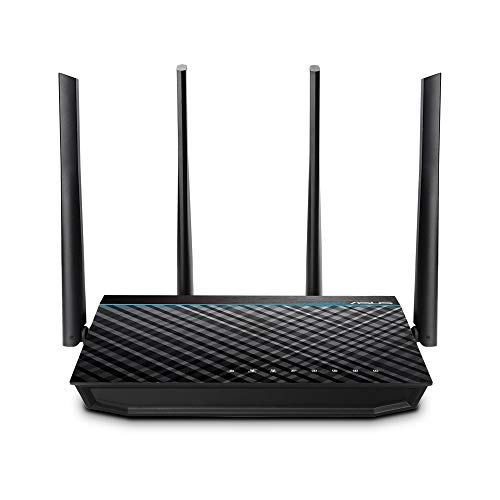Asus RT-ACRH17 Review
Dual-Band Gigabit Router with MU-MIMO, Quad-Core Processor, Optimized Coverage with AiRadar Beamforming, and intuitive ASUSWRT user interface.
The Asus RT-ACRH17 is an AC1700 router that was introduced a little more than a year ago as a successor to the reasonably successful RT-ACRH13. Because it is a member of the exclusive RH series, it is only available in a few countries, including the United States.
With the RT-ACRH13, ASUS attempted to test whether it could implement more demanding features in a more affordable device, and the RT-ACRH17 follows suit by opting for Qualcomm chipsets instead of the manufacturer’s standard Broadcom chipset (this means no support for the ASUSWRT-Merlin third-party software).
In addition, while the ACRH17 is advertised as a dual-band tri-stream router, its internal hardware suggests that it could have very well supported three bands and four streams (since it is equipped in a manner similar to that of the Zyxel Multy X and Netgear Orbi).
However, like its predecessor, the RT-ACRH17 is reasonably priced and promises to deliver wireless performance that is above its advertised class, as well as a LAN performance that is above its advertised.
Due to the lack of support for AiMesh, you will be unable to use this router as part of a larger mesh network, as you would with the Broadcom-based AC1750 RT-AC66U B1 router.
Design
If you’re acquainted with the Asus RT-ACRH13, you’ll be pleased to know that the manufacturer didn’t make significant changes to the design plan, and the RT-ACRH17 ended up looking almost exactly like its predecessor.
Thus, the case remains rectangular, which, unlike the newer RT-AC86U, allows it to be seated horizontally; it has also retained the signature diamond shape pattern on the top (with a narrow blue band to break up the monotony of the all-black finish – it still retains fingerprints), and the same four antennas point upwards, two coming from the back and two coming from the lateral sides of the device. Unfortunately, because the antennas are already attached to the router’s body, they are unable to be removed or improved in any way.
According to the manufacturer’s specifications, the RT-ACRH17 measures 8.14 x 5.85 x 1.59 inches (LWH) and, aside from being somewhat heavier, a tiny increase in breadth is only another minor variation between the current model and its predecessor (which has a width of 1.39 inches).
It is apparent that Asus is primarily focused on the mid-to high-end consumer router market, and I observed that the 802.11ax standard has piqued the company’s interest. However, a slight change in the appearance of its “lesser” versions would have been appreciated (and no, this design is not as emblematic as the WRT line to keep pushing it forward on every new device).
Performance
Asus has adopted a handful of 802.11ac WAVE 2 capabilities in the RT-ACRH13 that have now become standard on virtually all new routers (yes, even the cheapest ones), and it appears that the Asus RT-ACRH17 comes with a similar set of functions while avoiding the use of the AiMesh technology on purpose.
This is a bit of a disappointment because many Asus routers, including older models such as the RT-AC68U (which I tested alongside the RT-AC86U using AiMesh) and one of its direct competitors, the RT-AC66U B1, support it – this means that the router can only be used as a stand-alone device and that you will not be able to create a mesh network with multiple Asus ACRH17 devices (at the same time, only the powerful tri-band routers will truly be able to deliver a proper wireless performance and the reason is the backhaul traffic handling).
The router does make use of AiRadar TX Beamforming, which means that it concentrates and optimizes the signal towards the wirelessly connected clients (using its proprietary RF fine-tuning), allowing it to extend signal coverage and, according to the manufacturer, improve network stability by increasing the signal strength.
The router also supports multiple users at the same time (MU-MIMO), which means that numerous clients may be serviced at the same time without having to fight for bandwidth (supports the connection of up to three compatible devices).
Specifications
- Network Standard
IEEE 802.11a, IEEE 802.11b, IEEE 802.11g, IEEE 802.11n, IEEE 802.11ac, IEEE 802.3, IEEE 802.3u, IEEE 802.11i, IEEE 802.11e, IPv4, IPv6
- Data Rate
802.11a : 6,9,12,18,24,36,48,54 Mbps
802.11b : 1, 2, 5.5, 11 Mbps
802.11g : 6,9,12,18,24,36,48,54 Mbps
802.11n: up to 300 Mbps
802.11ac: up to 1300 Mbps - Antenna
Fixed antenna x 4
- Transmit/Receive
MIMO technology
- Memory
128 MB Flash
256 MB RAM - Operating Frequency
2.4 GHz / 5 GHz
- Encryption
64-bit WEP, 128-bit WEP, WPA2-PSK, WPA-PSK, WPA-Enterprise, WPS support
- Dimensions
207 x 148.82 x 40.52 ~ cm (LxWxH) (Without Bezel)
- Weight
508.5 g
- Package Content
•Wireless Router
•AC adapter
•Network cable (RJ-45)
•Quick Start Guide - Operation mode
Wireless router mode
Access point mode
Conclusion
Asus hasn’t made any substantial modifications to the design formula for its low-to-mid-range routers, but even while the RT-ACRH17 doesn’t adhere to the newest design trends, it still manages to be an attractive low-cost option, thanks in part to its excellent wireless performance on the 5GHz band.
Furthermore, both the web-based user interface and the mobile application provide a wealth of choices that are suited for both novice and expert users alike.
It is undeniable that the router might have been more than it is (the hardware supports three bands), but if you are not worried by the lack of support from third-party developers, the Asus RT-ACRH17 is one of the best routers in its class and one of the greatest overall values available (where it has purposely positioned itself so that barely any competitor can rise up to its performance).





